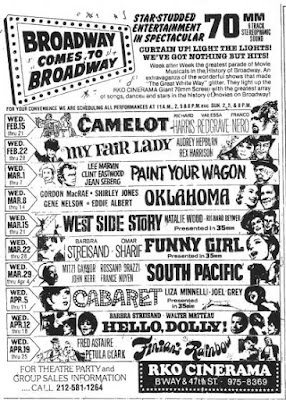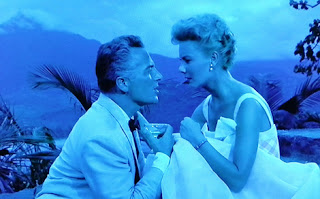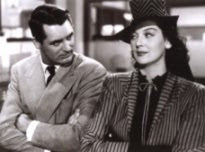Which means the film's first musical number wasn't the seabees' antic "Bloody Mary" - which has always opened the film, following a brief airborne scene between John Kerr and Tom Laughlin - but rather, "Dites-Moi," "A Cockeyed Optimist" and "Twin Soliloquies"/"Some Enchanted Evening," which introduced the characters of Nellie Forbush (played by Mitzi Gaynor), Emile De Becque (Rossano Brazzi) and De Becque's children in one continuous sequence set at De Becque's hilltop estate.
The version that I saw in 1979 opened with the De Becque children singing "Dites-Moi." The "Bloody Mary" number followed about ten minutes later.
click on image to enlarge
"Broadway Comes to Broadway" was a series of nine roadshow musicals (plus "Cabaret"), most of them shown in 70mm. Both "South Pacific" and "Oklahoma!" were screened in Todd-AO, the latter particularly gorgeous in that format. But the version of "South Pacific" that Ralph secured was the real find of the series. He told me that the print was acquired from the people overseeing the Rodgers and Hammerstein estate. ("South Pacific" was made independently by the Magna Theater Corporation, which developed Todd-AO, and then distributed by Twentieth Century-Fox.)
The film that Ralph screened ran 171 minutes, which was its running time for a few weeks in 1958 before the powers elected to trim it down to 157 minutes (following less than enthusiastic reviews). The 14 minutes eliminated from the film consist mostly of trimmed dialogue here and there and much of it reduced Ray Walston's Luther Billis character.
The 171-minute and 157-minute versions of "South Pacific" are both included on the DVD and BluRay discs, but the longer cut on home entertainment has the usual/familiar order of sequences.
The souvenir program for "South Pacific," which is rather creative and arty for a movie program (designed, no less, than by legendary production designers Dale Hennesy and John De Cuir), includes a section called "the continuity...," which is the film from the point of view of its editor Bob Simpson - and, again, the opening follows the contours of the play.
If I had to guess, I would say that Logan's decision to change the chronology of the early musical numbers prior to the film's opening was made strictly for commercial reasons. It's more audience-friendly to open the film with something rousing like "Bloody Mary" than with the moody and introspective "Some Enchanted Evening." Just a hunch.
Finally, there's Paul Osborn's screenplay for "South Pacific" (final draft, dated August 8th, 1957), which is available from Script City, that corroborates the continuity detailed in the film's program and the movie that I saw that day at the RKO Cinerama.
Regarding that song, the version of it performed by Mitzi Gaynor was trimmed - truncated actually - way before the film's release, with the entire middle (sung by a chorus of nurese) eliminated. Rumor has it that Rodgers and Hammerstein wanted the song cut from the film altogether. From their perspective, while it was a big moment in the play - i.e., the novelty of the leading lady washing her hair on stage every night - it made less sense on film. It was less of a novelty in a movie. Also, it was a popular song - too popular to cut out entirely. So it was merely trimmed.
Writing this makes me wonder if that version of "South Pacific" is still in the archives of the Rodgers and Hammerstein estate. I hope so.
Note in Passing: Ralph Donnelly passed on September 21st, 2007. He was 75. He's missed.
Regarding Comments: All comments are enthusiastically appreciated but are moderated before publication. Replies signed "unknown" or "anonymous" are not encouraged. Please sign any response with a name (real or fabricated) or initials. Be advised that a "name" will be assigned to any accepted post signed "unknown" or "anonymous." Thank you.
~images~
(from top)
~The opening title cards for "South Pacific"
-The advertisement for the RKO Cinerama's "Broadway Comes to Broadway" series in 1979
~Rosanno Brazzi and Mitzi Gaynor in a scene from the film
~Gaynor in the "Twin Soliloquies" number
-The advertisement for the RKO Cinerama's "Broadway Comes to Broadway" series in 1979
~Rosanno Brazzi and Mitzi Gaynor in a scene from the film
~Gaynor in the "Twin Soliloquies" number
~photography: Magna Theater Corporation/Twentieth Century-Fox 1958©























22 comments:
Since we're talking about alternate versions of "South Pacific," I remember reading that there was a debate during the recent restoration of "South Pacific" whether the colored filters used to add "mood" to the musical numbers should be removed. The filters were distracting to most critics at the time of release and they colored (no pun intended) in a negative way people's opinions of the film. The restorers ultimately decided to leave the filters in place because they were part of the film's history.
I was sorry to read that this decision had been made. Director Joshua Logan had himself asked Fox to remove the filters AFTER initial exhibitions of the movie had taken place because he felt their inclusion had ruined the film. Fox had refused to remove them at the time on the grounds that it would have been too expensive to withdrawal the film and then re-release it in a different version. Logan spent the rest of his life apologizing for the use of the filters whenever the film was mentioned.
With all the attention given today to director's cuts of films that had been altered by their studios, shouldn't we also have a version of "South Pacific" that conforms to the director's final wishes?
Jim- To the best of my knowledge, the filters were completely Joshua Logan's idea.
The cinematographer, the great Leon Shamroy, strongly advised against them because once the movie was filmed through the filters, the look was permanent. The appearance of the film couldn't be changed. Shamroy suggested tinting the film in post-production instead, but Logan was adamant. He wanted the filters.
Logan claiming that he asked Fox to "remove" the filters frankly doesn't make sense. Even if Fox agreed with him, it simply couldn't be done, as far as I know. Both Fox and Logan were stuck with the coloring that the filters provided.
Personally, I can't understand why critics of the film continue to complain about the filters. They work perfectly fine, putting the audience in the mood for a musical number. It was a very creative idea and, given that most audiences are uncomfortable when characters in a film suddenly burst into song, I'm surprised it hasn't been used more often, as it "prepares" the viewer for a song.
BTW, for me, the nighttime sequence prior to the film's intermission is gorgeous because the filter used by Shamroy gave the scene a black-&-white look. Very dramatic.
Anyway, based on the info that you have, it sounds as if Logan was trying to save face and placate his critics. Instead, he should have stood behind his gutsy decision. He should have been proud of his experiment.
Logan himself wrote that he wanted the filters removed:
"When [Logan] asked to have them removed, he found out that it couldn't be done in time to meet the film's bookings, so it went out with the tinting. In his memoirs, he would write that he wanted to picket each showing of the film with a sign reading, "I DIRECTED IT, AND I DON'T LIKE THE COLOR EITHER!"
Joe- I don't know if your DVD has the same commentary on the roadshow disc as the Blu Ray that I own, but the commentator mentions that "the European release" of the roadshow version was in the same running order as the show, and that the souvenir book sold at the showings, as you mention, had the songs in the "Broadway" order.
Brian! Thanks much for the added info. Interesting that Logan's original cut made it into the European markets
When I first saw the movie decades ago (!), the second verse of "I'm gonna wash that man right out of m hair" was included. I remember the theater manager, who was a friend, commenting that a new print was coming in and the notes said that the song would be shortened.
Connie- I'm reluctant to challenge you, but even the souvenir program has an editor's note referring to the trimming of the song. I've seen the film more times than I care to admit and the song is always truncated.
As I recall, I was sitting next to you at that show and it was at the Rivoli, but I recall it as just being in 70mm, but shown on their old curved Cinerama screen. The only theater that had shown Todd-AO was the Rivoli, and that's where the premiere of the film was.
But, the Cinerama (which was around the corner from my apartment), at least had the deep curve screen from its Cinerama (3-strip) days.
There's a really wonderful website which will give you some further info, including a memo from Logan regarding the filters.
For those of you who are Cinerama fans, if you can manage to be in Bradford, England on Saturday, October 13 @9am, you can get to see an original 3-strip Cinerama screening of How the West Was Won
Here are the links:
http://www.widescreenmuseum.com/widescreen/wingto11.htm
https://www.scienceandmediamuseum.org.uk/whats-on/widescreen-weekend/how-west-was-won
Thanks for the info and the links, Paul. And, yes, we did see the film that day together, but, no, it was not at the Rivoli. It was indeed the RKO Cinerama. I even ran the ad for the series along with my essay! Ralph found an old Todd-AO projector and had it installed in the theater for both “Oklahoma!” and “South Pacific” for the occasion, and I vaguely recall him saying that he got it from the Rivoli. -J
Joe, you jogged my memory once again. I remember that musical series well. It was at what was once the Warner Cinerama (and was called The Strand before that). I also saw It's a Mad Mad Mad Mad World and Grand Prix there, and George Stevens' Greatest Story Ever Told when it ran over 4 hours!). I always thought the film version of South Pacific got a bum rap from critics. It is gorgeous to look at and listen to (It does wobble in the last 30 minutes but recovers for that final glorious crane shot that gives me chills). The duet between John Kerr and Mitzi Gaynor - My Girl Back Home - is a favorite moment, beautifully touching. I am also puzzled by a generation that will swoon over music videos and shows like Glee, yet complain that the singing in old movie musicals is unreal and corny. It displays an embarrassing cultural ignorance of an art form that is a specifically American contribution. You've got to be carefully taught, I guess.
Kevin- Small world. I also saw "It's a Mad, Mad, Mad, Mad World" at the Warner Cinerama. Sid Caesar was there and he was signing everyone's souvenir program, including mine. I still have it. Funny, every time I tell someone my "South Pacific" story, I identify the theater in question as the Warner Cinerama, forgetting that, at one point, it was sold to RKO. -J
To Kevin Barry- Re, the "My Girl Back Home" number, I believe that it was the only song removed from the "European" version of the film that I mentioned in my previous post.
You know, Brian, I can't fully recall but "My Girl Back Home" might have been missing from the print I saw in New York in '79. Not sure. I'll have to check with Paul M. Paul are you there? -J
Joe,
I remember being vexed that "My Girl Back Home" was not in the print we saw.
I'm currently doing a bit of research about the version that was "discovered" in a collector's closet and subsequently shown in Bradford, England at the 2005 Widescreen Weekend festival I'll let you know what I come up with. But, since that print was subsequently shipped to California to use for the blu-ray/dvd release, I don't think it's the version we saw. (I just skimmed the blu-ray to check the order on the "roadshow" disc.
Paul- If "My Girl Back Home" was not in the print of "South Pacific" that we saw in '79, it kind of makes sense, given that the version we saw was planned to faithfully follow the original stage musical. Fact is "My Girl Back Home" was not in the play. It was added to the film, presumably so that Rodger and Hammerstein could qualify for a "best original song" Oscar nomination. At some point, it was decided by the powers not to replicate the play and so the opening numbers were re-arranged and "My Girl Back Home" - perhaps filmed with the idea that it might never be used - was added for the film's release. -J
I just saw this on a large theater screen as part of some ' oldies but goodies' films show at the Cinemark theaters, presumably wherever they are located, and have to admit, it;s still one of my all time favorite musicals, the others two being ' Singin' in the Rain' and ' West Side Story', and yes, I will also add ' Band Wagon'.........
Wow! What a year that was. We did much the same thing in Sydney in 1974 with roadshow musicals. When I saw the "South Pacific" title card, I nearly fainted. Yeah, what a year.
Joe
I worked at Sardi’s as the “celebrity” captain (in other words, I took care of the prima dons and donnas). Joshua Logan came in a few times and I asked him once about that print we saw. He didn’t know it existed. He was going to check on it, but I never saw him again.
The answer from the Festival director was that the “discovered” print is what’s on the Blu-ray Disc 2. Not what we saw.
This is going to end up as our own Rosebud.
I seem to recall a DVD release of SP that included a faded version of the roadshow cut as a bonus. Perhaps there are still copies out there.
Yes, Mike, the DVD does contain the roadshow cut - or at least the regular version with the cut stuff - all faded - re-inserted. The entire film isn't faded, just the added material. -J
Also, Joe, I was 6 when the film was released. My family owned shops on the boardwalk in Wildwood, NJ. Just up from my grandparents store was a movie theater which showed "roadshow" versions of films, usually one film all summer. When they showed South Pacific, they place a large stereo record player on the boardwalk in front of the theater and played the soundtrack album over and over and over.
You could hear the music clear from the beach where I would play. So, after a couple of weeks, a 6 year old could sing every song in the film. It's one reason why I have a special memory when I see the film.
Wonderful story, Paul! -J
Post a Comment